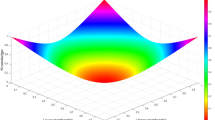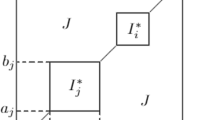Abstract
The problem of merging multiple-source uncertain information is a crucial issue in many applications. This paper proposes an analysis of possibilistic merging operators where uncertain information is encoded by means of product-based (or quantitative) possibilistic networks. We first show that the product-based merging of possibilistic networks having the same DAG structures can be easily achieved in a polynomial time. We then propose solutions to merge possibilistic networks having different structures and where the union of their graphs is free of cycles. Then we show how to deal with merged networks having cycles. Lastly, we handle the sub-normalization problem which reflects the presence of conflicts between different sources.
Similar content being viewed by others
References
Baral C, Kraus S, Minker J, Subrahmanian VS (1992) Combining knowledge bases consisting in first order theories. Comput Intell 8:45–71
Barra V, Boire JY (2000) Quantification of brain tissue volumes using mr/mr fusion. In: Proceedings of the World Congress on medical physics and biomedical engineering, pp 1404–1410
Ben Amor N, Benferhat S, Dubois D, Geffner H, Prade H (2000) Independence in qualitative uncertainty frameworks. In: Proceedings of the 7th international conference on principles of knowledge representation and reasoning (KR2000), pp 235–246
Ben Amor N, Benferhat S, Mellouli K (2001) A two steps algorithm for min-based possibilistic causal networks. In: Proceedings of 6th European conference on symbolic and quantitative approaches to reasoning with uncertainty (ECSQARU’01), pp 266–277
Benferhat S, Dubois D, Prade H (1997) From semantic to syntactic approaches to information combination in possibilistic logic. In: Aggregation and fusion of imperfect information. Physica, Heidelburg, pp 141–151
Benferhat S, Dubois D, Prade H, Williams MA (2002) A practical approach to revising prioritized knowledge bases. Stud Log J 70:105–130
Benferhat S, Smaoui S (2007) Hybrid possibilistic networks. Int J Approx Reason 44:224–243
Benferhat S, Titouna F (2006) Aggregating quantitative possibilistic networks. In: Proceedings of the 9th international Florida artificial intelligence research (Flairs’06), pp 800–805
Borgelt C, Gebhardt J, Kruse R (1998) Possibilistic graphical models. In: Proceedings of international school for the synthesis of expert knowledge (ISSEK’98), pp 51–68
Bouchon-Meunier B, Marsala C (2002) Independence and possibilistic conditioning. Ann Math Artif Intell 35:107–124
Cholvy L (1998) Reasoning about merging information. In: Handbook of defeasible reasoning and uncertainty management systems, vol 3, pp 233–263
De Cooman G (1997) Possibility theory—Part I: Measure and integral theoretics groundwork; Part II: Conditional possibility; Part III: Possibilistic independence. Int J Gen Syst 25:291–371
De Mouzon O, El Faouzi N, Nowtny B, Morin JM, Chung E (2006) Data fusion for traffic and safety indicators. In: The intelligent roads perspectives. ITS world congress
Dechter R (1996) Bucket elimination: A unifying framework for probabilistic inference algorithms. In: Uncertainty in artificial intelligence (UAI’96), pp 211–219
Dubois D, Moral S, Prade H (1997) A semantics for possibility theory based on likelihoods. J Math Anal Appl 205:359–380
Dubois D, Ngyen HT, Prade H (1999) Possibility theory, probability and fuzzy sets: Misunderstandings, bridges and gaps. In: The handbook of fuzzy sets series, pp 343–438
Dubois D, Prade H (1988) Possibility theory: An approach to computerized processing of uncertainty. Plenum Press, New York
Dubois D, Prade H (1991) Possibilistic logic, preferential models, non-monotonicity and related issues. In: Proceedings IJCAI’91, pp 419–424
Dubois D, Prade H (1994) Possibility theory and data fusion in poorly informed environments. J Control Eng Pract 2:811–823
Fonck P (1992) Propagating uncertainty in a directed acyclic graph. In: Proceedings of international conference on information processing of uncertainty in knowledge based systems (IPMU’92), pp 17–20
Fonck P (1994) Conditional independence in possibility theory. In: Proceedings of the 10th conference on uncertainty in artificial intelligence (UAI’94), pp 221–226
Hisdal E (1978) Conditional possibilities independence and non interaction. Fuzzy Sets Syst 1:283–297
Jensen FV (1996) Introduction to Bayesian networks. UCL Press, London
JoseDel S, Moral S (2003) Qualitative combination of Bayesian networks. Int J Int Syst 18:237–249
Konieczny S, Perez R (1998) On the logic of merging. In: Proceedings of the 6th international conference on principles of knowledge representation and reasoning (KR’98), pp 488–498
Lin J (1996) Integration of weighted knowledge bases. Artif Intell 83:363–378
Lin J, Mendelzon AO (1998) Merging databases under constraints. Int J Coop Inf Syst 7:55–76
Maaref H, Oussalah M, Barret C (1999) Fusion de données capteurs en vue de la localisation absolue d’un robot mobile par une méthode basée sur la théorie des possibilités. comparaison avec le filtre de kalman. Trait Signal 16:345–359
Matzkevich I, Abramson B (1992) The topological fusion of Bayes nets. In: Proceedings of the 8th conference on uncertainty in artificial intelligence (UAI’92), Stanford, CA, USA, pp 191–198
Matzkevich I, Abramson B (1993) Some complexity considerations in the combination of belief networks. In: Proceedings of the 9th conference on uncertainty in artificial intelligence (UAI’93), San Fransisco, CA, pp 152–158
Pearl J (1988) Probabilistic reasoning in intelligent systems: Networks of plausible inference. Morgan Kaufmann, San Fransisco
Raptis SN, Tzafestas SG (2002) Object hypothesis support in the context of knowledge based fuzzy/possibilistic fusion of image descriptions. In: 3rd international conférence on information fusion, vol 1, pp 3–8
Sossai C, Bison P, Chemello G (2001) Sequent calculus and data fusion. Fuzzy Sets Syst 121:371–395
Sossai C, Chemello G (2002) Coherent functions in autonomous systems. J Mult-Valued Log Soft Comput 9:171–194
Zadeh L (1978) Fuzzy sets as a basis for a theory of possibility. Fuzzy Sets Syst 1:13–28
Author information
Authors and Affiliations
Corresponding author
Rights and permissions
About this article
Cite this article
Benferhat, S., Titouna, F. Fusion and normalization of quantitative possibilistic networks. Appl Intell 31, 135–160 (2009). https://doi.org/10.1007/s10489-008-0118-y
Received:
Accepted:
Published:
Issue Date:
DOI: https://doi.org/10.1007/s10489-008-0118-y




